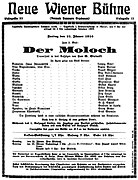Danzer's Orpheum
Danzer's Orpheum is a former theater in the 9th Viennese district of Alsergrund on the Wasagasse 33. It reached for 1900 about 900 seats, 20 boxes and 450 standing passengers. The stage was mainly known as a theater for operettas , variety shows and revues .
Harmony theater
A consortium of stock market speculators, whose common capital was pooled under the title Harmonie , built the “stately” Harmoniegasse connecting Liechtensteinstrasse and Wasagasse. After its completion, the financiers acquired a “very extensive” theater concession through the actress and theater director Amalie Pasqualati (1818–1903) with the aim of giving the ensemble of houses greater value by setting up an “art temple”.
The theater was built in 1864/65 by Otto Wagner in place of the so-called Engelhaus and opened as the sixth stage in Vienna on January 20, 1866 under the name, Harmonietheater , which refers to the traffic area . Until May 1867 it was under the management of the concession holder. The “quite tastefully decorated” stage held 800 spectators with only one gallery and 20 boxes. On the opening evening, four one-act “novelties”, two comedies and two operettas were performed, including An Adventure on Outposts by Hippolyth Kneissler (1831–1883; pseudonym for Erik Nessl) and music by Francisco Asenjo Barbieri .
The first conductor of the house was Carl Ferdinand Konradin (1833–1884), the second conductor was Carl Millöcker . Ludwig Anzengruber appeared here as an actor. The program included antics and Viennese operettas .
The theater had a Singspielhalle concession and was only allowed to perform one-act plays . Opposite the Theater an der Wien , which performed the elegant operettas for the upper classes, the easier operettas such as those by Ernst Reiterer could be seen here, similar to the Strampfer Theater or the Fürst Theater .
Danzer's Orpheum
In 1872 it was taken over by the innkeeper Eduard Danzer, who gave it the name Danzers Orpheum and mainly organized variety programs.
Around 1900 the theater was taken over by Gabor Steiner , decorated in a brilliant neo-baroque style and set up as a winter venue for the Venice amusement park in Vienna . It was opened with the operetta Venus auf Erden by Paul Lincke in the presence of the mayor Karl Lueger . The concession was extended, and revues could also be given with greater stage effort. Edmund Eysler worked here as a répétiteur . In 1903 the operetta The Beautiful Greek by the later Hollywood composer Max Steiner was performed here. Fritzi Massary became a star here until 1904 . Karl Tuschl , who had previously worked as an actor and director here, took over the theater management from Gabor Steiner in 1907.
New Viennese stage
Poster for the world premiere: The Moloch by Leo Birinski on January 21, 1910.
Poster for the Vienna premiere fools dance of Leo Birinski on 28 September 1912th
In 1908 the theater was named Neue Wiener Bühne and henceforth dedicated itself to acting. For example, the first performance of the tragedy The Moloch by Leo Birinski was here in January 1910 . From 1912, the director Emil Geyer made it a literary stage for expressionist drama and performed authors such as Georg Kaiser and Ferdinand Bruckner . One of the 11 simultaneous premieres was here on September 28, 1912, when Leo Birinski's tragic comedy Fools Dance. Alexander Moissi and Hermann Romberg worked here as actors . After the theater was turned into an entertainment theater again in 1925, it was closed in 1928.
The auditorium and stage were then dismantled and apartments on the street front were furnished in 1934.
New Vienna Stage was also called a small theater at Josefsgasse 8, which was in operation from 1957 to 1960.
literature
- Andrea Harrandt: Harmonietheater. In: Oesterreichisches Musiklexikon . Online edition, Vienna 2002 ff., ISBN 3-7001-3077-5 ; Print edition: Volume 2, Verlag der Österreichischen Akademie der Wissenschaften, Vienna 2003, ISBN 3-7001-3044-9 .
- Hans Pemmer: The Harmonietheater. 14th special exhibition of the Alsergrund local history museum from May 22nd to June 26th, 1966 . In: Contributions to local history of the IX. District of Vienna , No. 1. Alsergrund Local History Museum, Vienna 1966, OBV .
- Norbert Rubey , Peter Schoenwald: Venice in Vienna. Turn-of-the-century theater and entertainment city . Ueberreuter, Vienna 1996, ISBN 3-8000-3542-1 , p. 27 f.
- Gotthard Böhm: History of the New Vienna Stage . Two volumes. Dissertation. University of Vienna, Vienna 1966, OBV .
Web links
Individual evidence
- ^ Kratz & (Alexander) Strakosch : To the PT residents of Vienna !. In: Das Vaterland , No. 294/1865, December 24, 1865, p. 6 (unpaginated), bottom left. (Online at ANNO ). .
- ↑ a b The opening of the Harmonietheater. In: Das Vaterland , No. 18/1866 (VII. Year), January 24, 1866, p. 1 (unpaginated) below. (Online at ANNO ). .
- ↑ Harmonietheater. In: Wiener Zeitung , No. 18/1866, January 21, 1866, p. 221, top center. (Online at ANNO ).
- ↑ E (DGAR) Marktl: Pasqualati and Osterberg, Amalia baroness. In: Austrian Biographical Lexicon 1815–1950 (ÖBL). Volume 7, Verlag der Österreichischen Akademie der Wissenschaften, Vienna 1978, ISBN 3-7001-0187-2 , p. 334.
- ↑ Vienna Local Newspaper. (...) The sixth theater in Vienna. In: Das Vaterland , No. 9/1866 (VII. Year), January 13, 1866, p. 3 (unpaginated), column 3 below. (Online at ANNO ). .
- ^ Reopening of Danzer's Orpheum. In: Neuigkeits-Welt-Blatt , October 2, 1910, p. 12 (online at ANNO ).
- ^ Institute for Art and Music History Research: Harmonietheater. 2002, accessed February 3, 2019 .
Coordinates: 48 ° 13 '10.4 " N , 16 ° 21' 32.1" E



